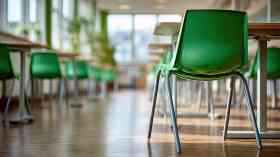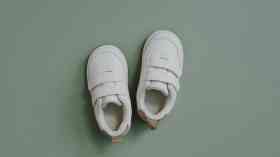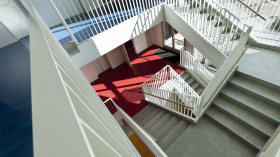Furniture Standards - A chair is not just a chair
 According to the Health and Safety Executive, more than 10 million working days were lost last year to musculoskeletal disorders (MSDs), including back pain and upper limb disorders, and 80 per cent of adults develop lower back pain at some point in their lives. There is also evidence that children who report cervical and/or lumbar pain suffer from poorer school performance.
According to the Health and Safety Executive, more than 10 million working days were lost last year to musculoskeletal disorders (MSDs), including back pain and upper limb disorders, and 80 per cent of adults develop lower back pain at some point in their lives. There is also evidence that children who report cervical and/or lumbar pain suffer from poorer school performance.
Back pain in children could, of course, be linked to carrying heavy school bags or a lack of exercise. However, unsuitable school furniture is certainly a major contributor to back pain in children and in later life.
Despite this evidence there have always been two sides of the debate. On the one hand many considered that fixed height furniture enables children to sit with a reasonable posture, providing that a variety of sizes (two in secondary schools) is provided in each class, and that children sit on and at furniture relevant to their individual heights. On the other hand, others felt strongly that schools should recognise the benefits of good posture and ergonomic comfort with any new investment in furniture.
BESA is committed to working with both schools and suppliers to raise the standards in education and therefore felt that a review of furniture in schools was long overdue. We worked with FIRA (Furniture Industries Research Association) and decided to start a process for change. Furniture standards at the time were based on the sizes of children measured in the 1960s.
We measured 1500 children of all ages across the country. The data confirmed what is obvious: children are generally taller but, importantly, the range of sizes in any age group is now wider. Children are also a different shape with, for example, very different ratios of body to leg lengths compared to the 60s. The implications for ergonomic furniture design are substantial.
Posture
Our research highlighted the benefits of good posture and ergonomic comfort in improved concentration and application. As previously touched on, there is evidence for such improvements in traditional learning environments when the furniture design and quality is improved. However, it became obvious that flexible learning environments, fit for our visions of 21st century education, required a transformation in our approach to furniture. For a learning space to be healthily used by every age group in a school (including adults), for it to allow movement and encourage flexible use, the furniture must have good ergonomic features such as adjustability, be fit for purpose and be comfortable.
For many schools faced with the prospect of purchasing their first new furniture for years, the problem was lack of experience and advice on what to buy. As heads scanned educational furniture catalogues they looked at prices that did not compare with the high street and unfortunately a proportion decided to buy ‘cheap’. They purchased household quality furniture, for as little as a third of the price of equivalent educational products and thought they had a good deal. Educational furniture manufacturers however, will tell you that the school environment is about the most hostile imaginable for a chair or table. Furniture members of the British Educational Suppliers Association (BESA) will normally manufacture to the British educational furniture standards BS4875 (strength and stability) and BS5873 (educational furniture), and now the European standard prEN1729 (chairs and tables for educational institutions). The latter is particularly to do with dimensions and ergonomic issues.
Complying with standards
In 2008 we fed our research data to standards bodies around Europe which resulted in the educational furniture standard, EN1729 which also had the support of DfE. Although all school furniture suppliers need to move to the new standard, they are currently only advisory. However, everyone involved in the provision of furniture for children has a duty of care. To comply with the BSEN 1729 Standard, products must pass two components. The first is the size and shape of the products, and the second the strength and stability. In summary, schools should check the functional dimensions of the furniture they are looking to purchase, ensure correct ergonomics for children’s back care and make certain products will stand up to classroom demands. BESA furniture members are at the forefront of trying to get the new standard used extensively in schools.
The group supply and supports all products that conform to all the relevant British Standards including EN1729 where relevant. Murray Hudson, sales & marketing director, Gratnells Ltd and and chair of BESA’s Furniture special interest group, explains further: “BESA members are committed to the provision of furniture which meets the highest and most up-to-date standards. BEFMG members work with European standards committees in the drafting of new standards.
Ergonomic Excellence
“An excellent example of this is the implementation of BSEN1729 – which recognises the importance of both ergonomic excellence and durability in use. BEFMG members have been at the forefront of the development of new products to match this standard – delivering products which support improved lifelong back care for our children, better academic outcomes through comfort which leads to improved concentration and outstanding value for money through product durability and life cycle costs.”
Jessica Marshall, marketing manager, Remploy Furniture, designer and manufacturer of high-quality, built-to-last education products supports this by adding; “It is important for furniture suppliers to be committed to continually maintain and improve product standards - both British and European. Schools should look to credible suppliers who are BESA members to ensure they receive the delivery of quality and durable product in the modern testing classroom environment.”
Christine Farmer, ABC Desks summarises: “We regularly see schools which have sadly based their purchasing decisions on price, only to find that not only do they break very quickly but that they do not provide a comfortable learning environment for the students. At ABC Desks our furniture lasts at least twice as long as any other on the market, so they are a sensible investment with a full seven year guarantee. As BESA members we are committed to supporting a positive learning environment.”
BESA Research
At BESA, our recent ‘Resources in English Maintained Schools’ research (January 2012) carried out in association with the National Education Research Panel (NERP) shows that schools are still investing in furniture, and hopefully adhering to the BSEN 1729 Standard, with an estimated £78m spending across 2012/13. Although the research showed a reduction in expenditure in furniture of -3.9 per cent in primary and 4 per cent in secondary schools, the projected reduction appears to be less dramatic for 2012/13. Primary schools are predicting a 2.6 per cent reduction while secondary schools forecast a minimal reduction in furniture expenditure of just 1.6 per cent. Looking further into the research, it appears that the combined reduction in anticipated spending over the two-year period is less than that expected from resource expenditure as a whole, which means that furniture may not be one of the most significant casualties of any resulting reduction in school incomes.
Further information
When you are looking for furniture, visit www.besa.org.uk for details of the standards you should buy to and the companies to buy from (all BESA members must annually sign up to abide by the BESA Code of Practice). This will help you ensure that you get quality that will last and represent best value, and design that will minimise medical problems.
Latest News
30/10/2025 - 01:28
In the wake of the Raac crisis, the DfE spent £5 million on research into the condition of school buildings, which is due to conclude in spring 2026.
30/10/2025 - 01:09
Malmesbury Primary School in Wiltshire has submitted plans for a major expansion, funded by entrepreneur James Dyson.
30/10/2025 - 00:55
Monday's Every Pair Tells a Story campaign to protest to highlight the national crisis in SEND provision.
29/10/2025 - 09:19
Estimated data from the Department for Education reveals that 470,000 pupils under 16s use local authority funded transport to get to school.
28/10/2025 - 09:29
Timeline set for removal of Reinforced Autoclaved Aerated Concrete







